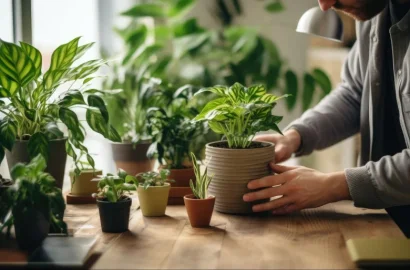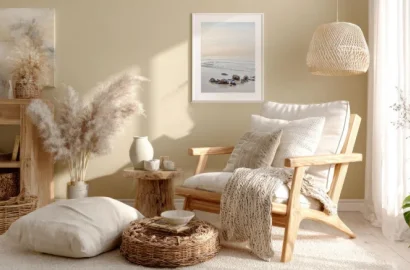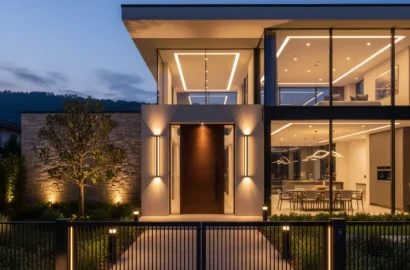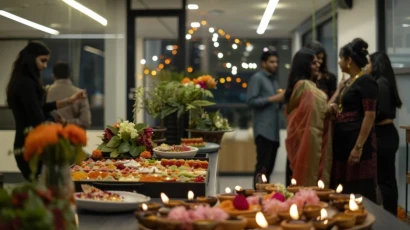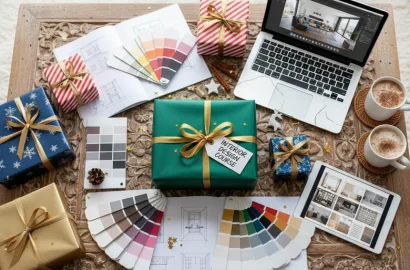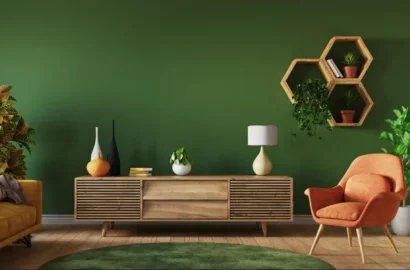Explore the various interior design jobs in Hyderabad. Learn all about the different roles a designer can pursue in the city with details on skills required to excel.
Long known to be one of the country’s leading IT hubs and business centers, Hyderabad’s focus on technology and innovation has consistently contributed to its economic stability and growth. This has led to more financial power among residents and a consequent increase in the demand for interior design services to cater to new homes, offices, retail spaces, and hotels.
With a growing community of designers and architects, Hyderabad also offers a supportive environment for collaboration, mentorship, and knowledge sharing. So if you are looking to pursue your interior design dreams in the city, this comprehensive list of common interior design job roles might be exactly what you need.
Here’s an overview of what we cover in this article.
- Why take up an interior design job in Hyderabad
- Residential interior designer
- Interior decorator
- Corporate interior designer
- Healthcare designer
- Retail interior designer
- Kitchen designer
- Visual merchandiser
- Lighting designer
- Colour consultant
- Where to Look for Interior Design Jobs
- Next Steps
Moving on to the details now!
Why Pursue an Interior Design Job in Hyderabad?
Hyderabad’s real estate market is rapidly growing, with numerous residential, commercial, and hospitality projects underway, which are opening up ample new opportunities for interior designers. Compared to other major cities in India, Hyderabad also offers a relatively lower cost of living, making it an attractive option for affordable housing, excellent commercial spaces, and a range of recreational activities.
The city’s growing economy, combined with its rich cultural heritage, offers a diverse and inspiring backdrop for interior designers to pursue creative design work. While salary ranges vary by industry and project, entry-level interior designers in Hyderabad can expect an average annual package of 3 lakhs per annum, with experienced professionals earning up to 11 lakhs per annum.
Interior Design Job Roles in Hyderabad
Now that we have covered why pursuing a career in interior design in Hyderabad could be a lucrative decision, here are some common interior design job roles in the city for your consideration.
1. Residential Interior Designer
One of the most common verticals within the field, residential interior design is concerned with designing, renovating or redesigning homes to meet the needs and desires of its occupants. With an upward rise in the spending capacity of the Indian population, residential interior design has grown exponentially with several families seeking professional services to enhance their living spaces.
An excellent example of everything that residential interior design entails, is this student project by AND learner Ishani Pati. The project showcases the design approach and different techniques used to deliver a design that meets client needs.
What skills do residential interior designers need?
A residential interior designer must be well-versed with the following skills:
- Knowledge of spatial planning, usability, and accessibility in living spaces
- Familiarity with ergonomics, anthropometrics, material selection, and finishes
- Understanding and proficiency in 3D modeling and rendering
- Ability to understand client briefs and manage stakeholders
- Collaboration and communication skills
- Project management and cost estimation skills
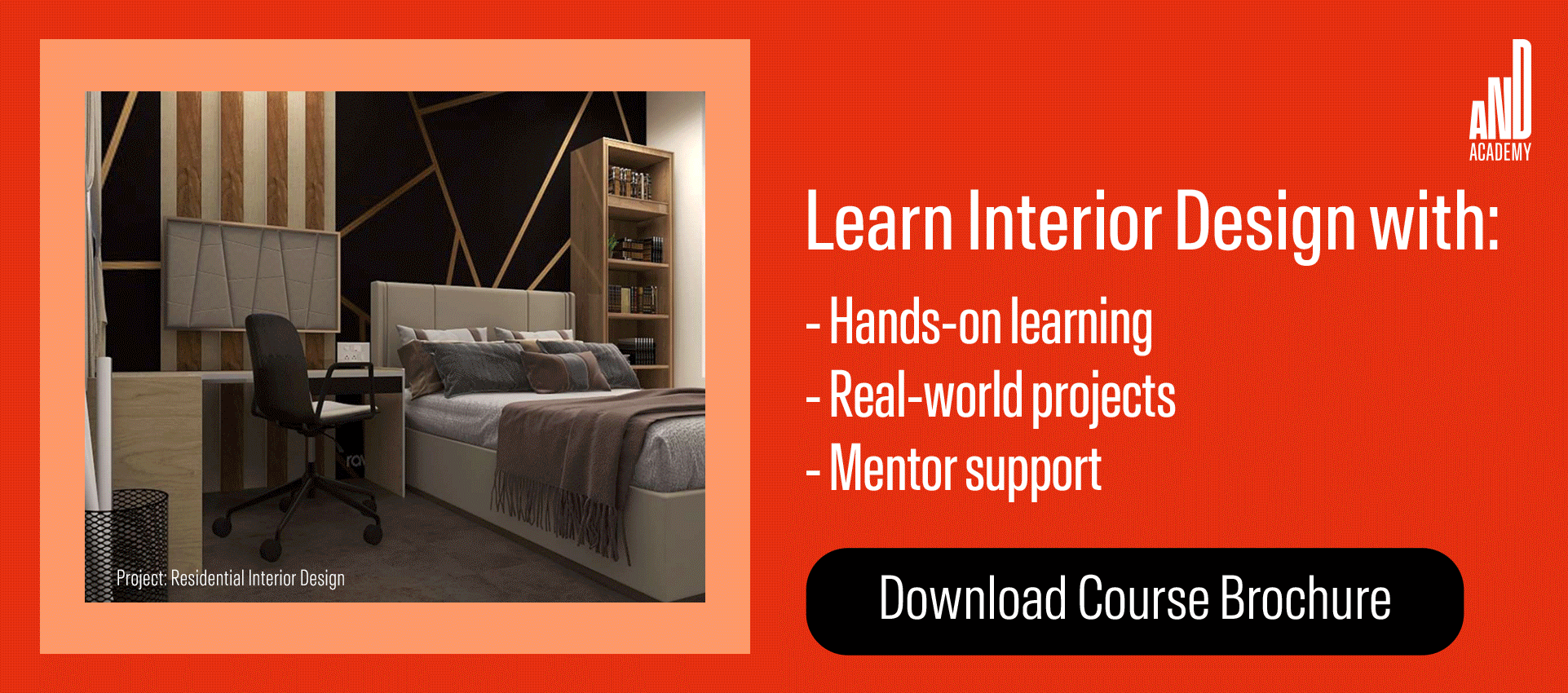
2. Interior Decorator
Although the scope of work of an interior decorator is slightly different from that of an interior designer, it has emerged as a popular career in the current landscape. Interior decorators are professionals trained in beautifying spaces and are adept at selecting an appropriate color scheme, defining a style or theme, and placing the right furniture. As such, interior decorators often collaborate with interior designers and focus on creating aesthetically pleasing and functionally decorated spaces.
What skills do interior decorators need?
Interior decorators must possess the following skills:
- An eye for detail and creativity
- Knowledge of furniture styles and designs, material selection, finishes, and lighting
- Familiarity with color psychology and theory
- Interpersonal communication and collaboration skills
- Project management and cost estimation skills
3. Corporate Interior Designer
Workplace safety and enhancing employee efficiency are major focus areas for corporate interior designers. As experts, these designers must carefully select colors, lighting options, and ergonomic furniture to create a professional space that effectively represents an organization’s work culture and ethics. Spatial planning is essential for such designers, who must ensure that modern offices are designed to suit the work culture, capture organizational values, boost employee productivity, and provide an efficient environment for occupants.
The choice of office layout, whether an open plan, private office, or coworking space, must align with overall work requirements. For instance, a cubicle layout for a workforce that engages in frequent close discussions is likely to decrease employee productivity and efficiency.
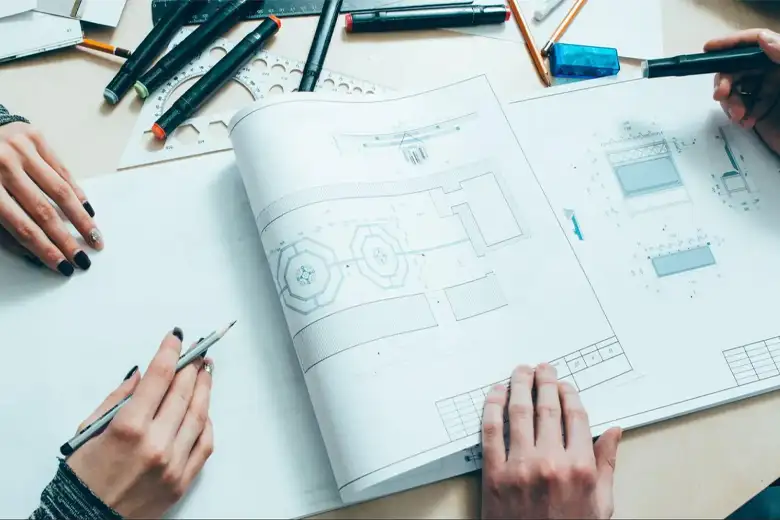
What skills do corporate interior designers need?
Office design is closely aligned with employee behavior and should contribute to better collaboration and engagement. A competent corporate designer must have the following skills:
- Deep understanding of spatial planning and design concepts like rhythm, balance, contrast, proportion and unity
- Familiarity with different office layouts and their benefits for different organizational setups
- Knowledge of the impact of lighting solutions, materials, furniture and color on human psychology and productivity
- Proficiency in 3D modeling and rendering software
- Collaboration and communication skills
- Project management and cost estimation skills
4. Healthcare Designer
Healthcare interior design focuses on creating functional, safe, and calming environments that prioritize patient-centric care. The primary aim is to design healthcare facilities in a way that enhances patient accessibility and movement, promotes healing and well-being, supports employee workflow, and fosters a sense of calm.
A key responsibility of healthcare interior designers is adherence to code compliance. This includes using strategic materials to prevent the spread of infection, adopting advanced technology, selecting appropriate color schemes to create a calming aesthetic, and ensuring proper lighting and furniture to reduce patient discomfort. Additionally, they must place signage strategically for intuitive wayfinding. The exact scope of these responsibilities can vary depending on the type of facility, such as hospitals, clinics, assisted living facilities, or children’s hospitals.
What skills do healthcare designers need?
Healthcare interior designers must possess specific skills. These include:
- In-depth knowledge of health compliance and safety regulations
- Familiarity with patient-centric design principles and practices
- Understanding of accessibility, ergonomics, and spatial planning to enhance patient comfort and staff workflow
- Color theory, knowledge of material that can help avoid the spread of infections and appropriate lighting solutions.
- Proficiency in interior design tools, 3D modeling, and rendering
- Collaboration and communication skills
- Project management and cost estimation skills
5. Retail Interior Designer
Retail interior designers specialize in spatial design focused on optimizing the shopping experience for customers. The primary responsibilities cater to designing the overall layout of the store to ensure an efficient flow for customers. This includes taking into consideration the foot traffic patterns and popular product demands to determine effective placement.
Beyond ensuring functionality and intuitive flow, designers also focus on creating aesthetic interiors that align with the brand identity and overall customer experience. Their day-to-day responsibilities include creating attractive displays, spatial planning and placements of new and older products in a store, utilizing color theory and materials to nudge consumer decisions, and researching current market trends.
What skills do retail interior designers need?
Retail designers require proficiency in a range of skills. These commonly include:
- Knowledge and understanding of the impact of layout on consumer behavior
- Familiarity with space planning and optimization
- Basic understanding of branding, color theory, and consumer psychology
- Knowledge of marketing concepts and visual merchandising
- Proficiency in 3D modeling and rendering
- Collaboration and communication skills
- Project management and cost estimation skills
6. Kitchen Designer
Although a branch of residential design, the popularity of kitchen renovations and redesign has made this into a specialized field. As the name suggests, kitchen designers work with clients to create, redesign, or upgrade kitchens for better efficiency and functionality. This includes understanding a client’s lifestyle, needs and aesthetic requirements to create a kitchen that seamlessly blends practicality with style.
Common responsibilities include client interviews, market and industry research for trending styles, project management, material selection, knowledge of building codes and regulations, and developing concepts. Kitchen designers can also work with commercial or hospitality clients, unlike residential interior designers who mostly collaborate with residential clients.
What skills do kitchen designers need?
- Familiarity with kitchen interior design styles and principles
- In-depth knowledge of construction materials and accessories
- Understanding of construction regulations and policies
- Proficiency in AutoCAD and other software tools
- Collaboration and communication skills
- Project management and cost estimation skills

7. Visual Merchandiser
Visual merchandising is a subcategory of retail interior design that mostly concerns a retail shop’s marketing and sales aspects. This includes strategic placement of product displays based on shopper behavior to drive sales or promote specific brands for profit. Consequently, visual merchandisers often need business and marketing acumen to achieve their goals.
It is important to note that visual merchandisers focus on profitability and hence form only a subcluster of retail interior design. On the other hand, retail interior designers focus on store layout for better customer experience. Although the scope of work of a visual merchandiser is limited compared to that of an interior designer, it is a lucrative niche within the field.
What skills do visual merchandisers need?
The key skills a visual merchandiser needs are:
- Strong understanding of marketing concepts and business acumen
- Deep understanding of consumer behavior
- Knowledge of interior design concepts and spatial optimization
- Strategic application of lighting systems, colors, and store layout
8. Lighting Designer
Lighting designers specialize in creating effective and aesthetically pleasing lighting solutions for various environments. Their work encompasses a wide range of settings, including theatres, architectural projects, outdoor spaces, events, and exhibitions. Common responsibilities include concept development and creating detailed lighting plans.
Given the specialized nature of the field, lighting designers can work in a range of industries and backgrounds. Efficient use of light is a necessity in the healthcare sector where the choice of lighting systems can greatly affect the mental and emotional state of a patient. Similarly, factors such as light levels, color temperature, beam angles, and distribution to achieve the desired effect play a significant role in hospitality and corporate offices.
What skills do lighting designers need?
Lighting design is a specialized career option that requires a unique set of skills. This includes:
- Understanding of electrical systems, wiring, and circuit design to ensure safe and effective installation of lighting systems.
- Basic understanding of Photometry or knowledge of light measurement to assess and design lighting conditions.
- Strong sense of design and aesthetics to create visually appealing lighting solutions
- Understanding of color temperature, color rendering index (CRI), and how different light sources affect color perception.
- Proficiency in lighting design software such as AutoCAD for drafting and visualizing lighting plans.
9. Color Consultant
Yet another specialized branch in the field of interior design. color consultants specialize in selecting and coordinating colors to create harmonious and aesthetically pleasing environments. Their expertise helps clients achieve the desired mood, style, and functionality in residential, commercial, and industrial spaces.
Key responsibilities of color consultants include recommending appropriate materials and finishes, coordinating colors with other design elements such as flooring, countertops, and cabinetry and suggesting lighting solutions that enhance the chosen color scheme. This specialized field can be particularly helpful for recreational projects where cultural and personal associations with colors are likely to impact the client’s experience of the space.
What skills do color consultants need?
Color consultants typically employ the following skills:
- Conducting client interviews and market research to balance client needs with current trends
- A deep understanding of color psychology and its impact on a space and its inhabitants
- Familiarity with interior design principles and ways to accentuate those through color
- Collaboration and communication skills
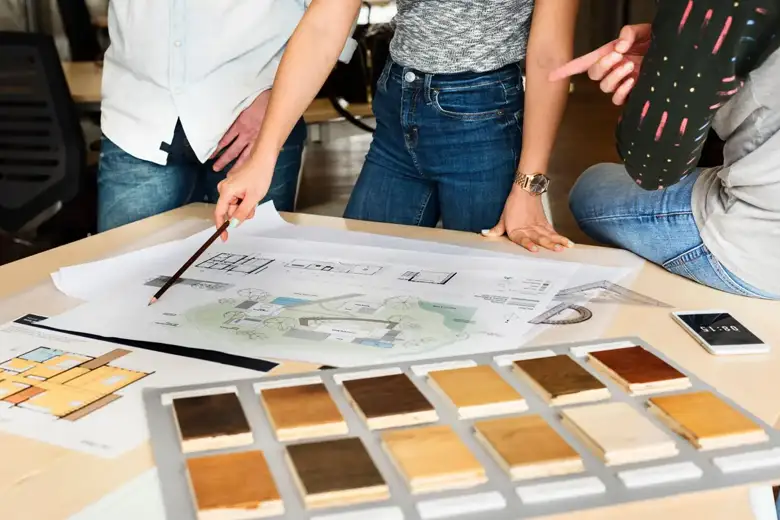
Where to Look For Interior Design Jobs
Finding a job in interior design requires a strategic approach that involves leveraging various resources and platforms. Here are some key places to look for interior design jobs in Hyderabad:
- LinkedIn: LinkedIn is an excellent networking site to find job listings, connect with industry professionals, and join interior design groups.
- Indeed: A comprehensive job search engine with numerous interior design job postings.
- Glassdoor: Offers job listings and company reviews, providing insights into potential employers.
- Naukri: Another job search engine that aggregates job listings from various sources.
- Architecture and Design Firm Websites: Many firms post job openings on their websites. Look for careers or employment sections on the websites of prominent design firms.
- Design Meetups and Workshops: Participate in local design meetups and workshops to connect with other professionals and learn about job opportunities.
- Social Media Platforms: Follow interior design firms and influencers who often post about job openings and freelance opportunities. Join groups related to interior design jobs and networking.
- Fiverr: An excellent platform for freelancers to find short-term interior design projects.
- Behance: A design website, Behance allows designers to upload their work and organically connect with prospective recruiters and clients.
By exploring these resources and maintaining an active presence in the interior design community, you can increase your chances of finding suitable job opportunities in the field.
Next Steps
In this complete guide to the best interior design jobs in Hyderabad, we’ve looked at common and upcoming job roles that promise a steady and stable career in the city. We’ve also outlined the different resources that interested designers can consider to land a successful career as interior designers.
However, If you’d like to know more about interior design, we recommend checking out AND’s Design Blog.
If you’d like some additional resources, here are some to consider:
- Watch this session by Snehanshu Mukherjee, Founding Partner at T.E.A.M and Mansi Almadi, an Interior Designer at Studio Lotus
- Talk to a course advisor to discuss how you can transform your career with one of our courses.
- Check out our Interior Design courses – all courses are taught through live, interactive classes by industry experts.
- Take advantage of our scholarship and funding options to overcome any financial hurdle on the path of your career transformation.
Note: All information and/or data from external sources is believed to be accurate as of the date of publication.


